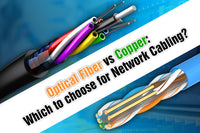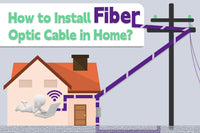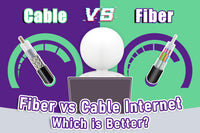With the increasing need for high-speed, stable internet to support bandwidth-intensive applications like VR and AI technology, the fiber optic network has stood out as a new standard for high-speed connectivity. But what exactly is a fiber optic network, and how does it enhance connectivity? Dive deeply into the world of fiber optic networks to discover more about the fiber optic network and benefits they bring.
What is Fiber Optic Network?
A fiber optic network, also known as fiber optic internet, is a broadband connection using fiber optic technology in which fiber optic cables deliver data by light pulses along glass or plastic fibers. The fiber optic network can be traced back to the 1970s when it was initially deployed in telecommunications infrastructure. It provides high-speed connectivity with minimal signal attenuation and interference resistance compared to previous mediums such as coaxial and twisted pair cables. This means fiber optic cables can transmit data over longer distances without significant signal loss.
How Does Fiber Optic Network Work?
Fiber optic network works through ultra-thin optical fibers. The optical fibers carry light signals over extensive distances until they are captured by optical network terminals (ONTs) and converted into electrical signals. The light signals represent data in a binary form of light or no light. Fiber optic networks frequently employ optical amplifiers to maintain signal stability and prevent data loss over a long distance.
The last mile: It refers to the final distance from the nearest provider’s network infrastructure to end users. The physical length of a last-mile network link can be shorter than one mile. Although copper cables still play a role as a substitute in last-mile laying, optical fiber is the ideal medium for the last mile.

Types of Fiber Optic Networks
The growing demand for faster internet boosts fiber optic technology. Fiber-to-the-X (FTTX) technologies have been continuously developed to provide reliable residential and commercial internet connections for last-mile applications, including FTTN, FTTC, and FTTP. We will delve into an in-depth comparison of these fiber optic network types.
- FTTN: Short for Fiber to the Node, FTTN means the fiber is terminated at a central node near the customer's location. Copper or coaxial cables are used in the last mileto transmit data from the central points to individual homes. Though FTTN can be more cost-effective than FTTH infrastructure, residing further from the node may result in increased attenuation and latency issues.
- FTTC (Fiber to the Curb): Also known as FTTK (Fiber to the Kerb), FTTC involves terminating the fiber optic connection to a street utility box close to the customer's location, and uses coaxial or twisted pair cables to connect to the premises. FTTC offers higher speed and bandwidth compared to FTTN, primarily because the fiber is terminated closer to the customer’s location. However, transitioning to copper or coaxial cables in the last mile may still result in losses of speed and reliability, particularly for longer distances.
- FTTP (Fiber to the Premises): FTTP is a broad term, including FTTH and FTTB. FTTB (Fiber to the Building) means that the fiber reaches the building but ultimately connects to each floor via alternative mediums. In FTTH (Fiber to the Home), fiber optic linksreach the boundary of a residential or office space, which usually uses a fiber optic connection in the last mile. FTTH stands as the optimal type of fiber optic network, providing the highest bandwidth and signal integrity.

DSL vs. Cable vs. Fiber
Before the advent of fiber optic cables, wired internet connections primarily relied on copper wires like the digital subscriber line (DSL) and cable internet.
DSL is an old internet technology delivering data via telephone lines. Its key advantage over dial-up connections is that it uses different frequencies for telephone and internet connections. However, DSL internet provides relatively low speeds, making it less adept at handling high-speed data activities like streaming and gaming in modern settings.
Cable internet is widely used for broadband connections. It uses coaxial cables that are also used for cable television (CATV) transmission. Most internet service providers (ISPs) can provide cable internet download speeds of 100 Mbps or more, but the upload speeds cannot exceed 50 Mbps. Cable internet has faster download and upload speeds than DSL connections and supports multiple devices simultaneously. However, its network speed can slow down during periods of network congestion.
Fiber internet provides higher reliability and speed than the former two internet connections. It can not only support various devices at the same time but also offer symmetrical upload and download speeds. Fiber internet boasts abundant bandwidth to satisfy everyone in the same network and benefits a lot for remote work, large file transfers, and video conferences. Nonetheless, it is unavailable in all regions and is generally more expensive than DSL and cable internet.
For more details on this topic, please refer to our blog comparing Fiber and Cable Internet.
5 Benefits of Fiber Optic Network
Optical fibers are an essential alternative for the worldwide internet, transmitting data across continents and beneath oceans. It is a preferred option for bandwidth-intensive family and business applications. Fiber optic home networks or office networks can offer the maximum network performance. Now, let's delve into the distinct advantages of fiber optic networks.
Superior Speed
Fiber optic networks transmit data over incredibly high speeds, surpassing traditional copper wire connections. While commonly achieving up to 1000 Mbps, fiber optic speeds can reach staggering rates of up to 10 Gbps and beyond. The powerful fiber network enables robust connectivity for multiple users in a single place, accommodating numerous smartphones, tablets, laptops, and other IoT devices. Furthermore, the low latency of fiber networks makes them ideal for bandwidth-intensive activities such as streaming, online gaming, and autonomous driving technology.
Unlike traditional wired connections with copper, fiber cable internet features symmetrical upload and download speeds. The balanced bandwidth allocation for both sending and receiving data ensures optimal performance for activities such as gaming, video conferencing, live streaming, and data synchronization.
Reliability
On the one hand, fiber optic networks are almost free from signal attenuation and immune to electromagnetic interference. And it can better handle variable temperatures and extreme weather, maintaining stable and reliable data transmission.
On the other hand, the fiber optic network remains unaffected under peak traffic due to its extensive bandwidth. So it can accommodate multiple devices and users simultaneously, delivering uninterrupted and consistently high-speed connectivity during periods of high usage.
Security
The transmission of optical signals is hard to intercept, which provides a barrier against hacker activities and enhances personal information security. Furthermore, faster and more reliable fiber optic internet contributes to public safety, whether it involves rescue operations, first aid, or disaster response.
Scalability
Fiber optic networks offer vast bandwidth potential, and you can enjoy higher fibre broadband with the upgrade of hardware equipment rather than fiber optic cables. This scalability makes fiber optic networks extremely adaptable to fluctuations in internet speeds. It can meet the growth demand of enterprises and communities, catering to the evolving needs of users for a more advanced online experience.
Future-proofing
Network equipment has been continuously upgraded to meet the increased demand for faster networks, and fiber optic cables are emerging as a future-proofing option for high-speed network transmission. Fiber optic networks boast lower maintenance costs and offer exceptional durability, ensuring sustained performance. In addition, fiber optic networks are more energy-saving, using light rather than electrical signals for communication, and fiber optic cables are also more environmentally friendly than copper cables.
Conclusion
Future-proof fiber optic technology is the cornerstone of innovation in the information age, which provides stable signal delivery, empowers remote applications, and enhances connectivity. Despite some drawbacks such as limited availability and high costs, fiber optic network is still a prior option for large businesses seeking reliable and high-performance solutions.
FAQs
Is fiber optic internet better than Wi-Fi?
Fiber optic internet provides faster speeds than Wi-Fi; while Wi-Fi offers added flexibility. The combination of fiber optic internet and Wi-Fi can achieve optimal network performance.
What is the best internet speed for individual use?
The speed of 1,000 Mbps or more offered by most ISPs is excellent for businesses, large families, and heavy internet users. However, this top-tier plan may not be necessary for everyone. If you want to save money on broadband plans, 300 Mbps and 500 Mbps are practical for average households, providing a superior experience in gaming, video streaming, and more.
Do I need a modem and router for fiber optic internet?
Instead of a modem, fiber optic internet uses an optical network terminal (ONT), also referred to as a fiber network terminal or fiber jack. Then you can connect an Ethernet cable or fiber router to the ONT for connectivity.
For more information on this topic, you can keep up on our blogs. While VCELINK offers general and basic information for our customers and other visitors to the website, it’s not professional advice.




Be the first one to comment.
Leave a comment